Simple routines for moms that actually work with ADHD. From mornings to bedtime, make daily life easier without overcomplicating it.
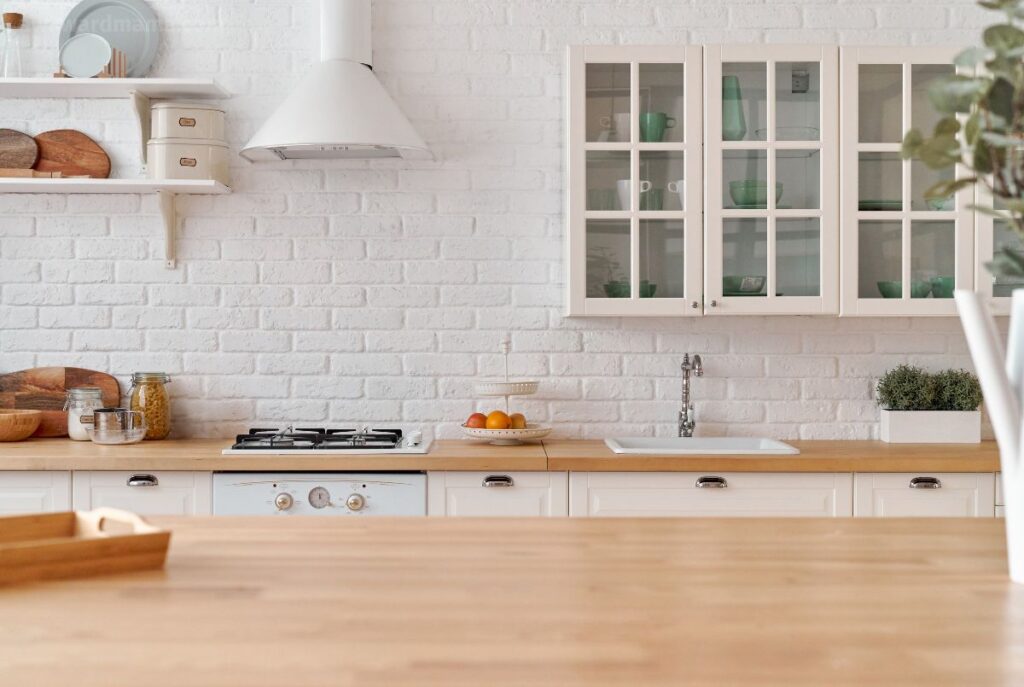
If your days feel like they’re running you instead of the other way around, this is for you.
Because same. I’ve tried the fancy planners, the color-coded charts, and those “wake up at 5 AM” routines Instagram swears will change your life.
I even wrote a post about waking up before your kids — and it actually worked… until I had another baby, lol.
And you know what? I crashed and burned on all of it. Which meant I wasn’t just overwhelmed — I was overwhelmed and convinced I was failing at motherhood.
Here’s the thing no one tells you: complicated systems almost never work when you’re an exhausted, ADHD, default parent.
We forget about the dentist appointment until it’s 20 minutes away. We realize we’re out of milk exactly when we start cooking dinner. We restart the same load of laundry three times because… well, life be lifin’.
What finally worked for me wasn’t “trying harder” — it was building my way of doing things.
Small, repeatable routines that make sense for my actual brain, my actual energy levels, and my actual family with a bunch of kids.
This list walks you through 16 simple routines — from morning to night — plus a few quick resets to keep life from completely spiraling.
You don’t need to start them all at once (PLEASE don’t!!). Pick one, make it stick, then stack another on top. Imperfect consistency still changes everything.
(PS: This post probably contains affiliate links. As an Amazon associate, I earn from qualifying purchases. This means I may be rewarded monetarily or otherwise upon purchase through these links, at no additional cost to you. If you want to read the boring legal stuff, you can find my full disclosure here.)
1. Start with a Morning Routine That Works for Your Brain
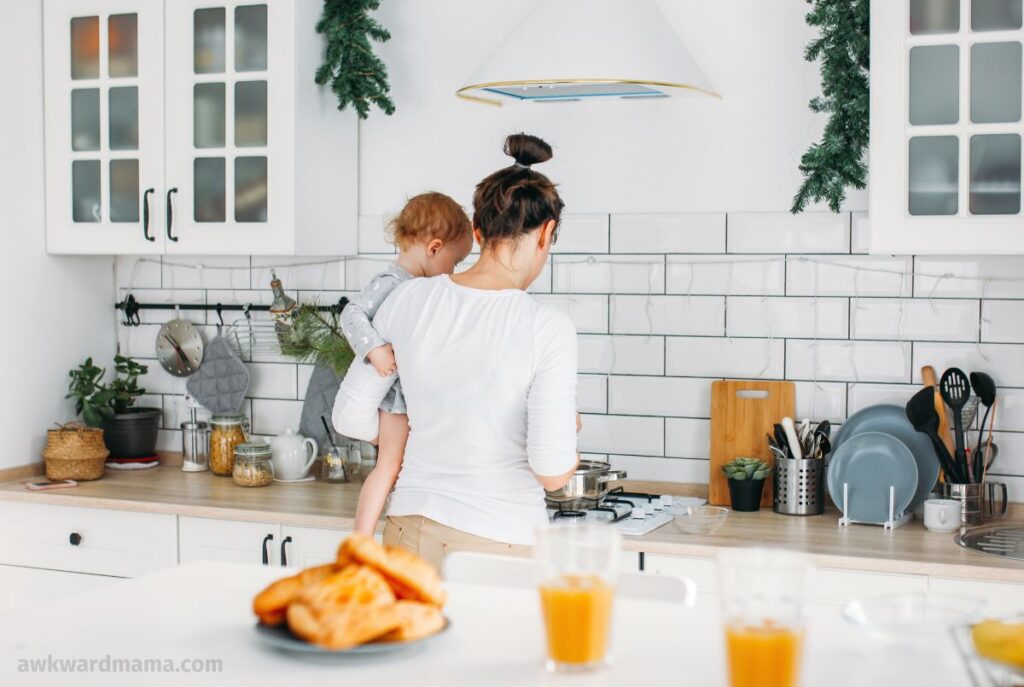
Forget the “perfect” 4:30 AM wake-up calls. Unless you like mornings that early (in which case… couldn’t be me no matter how many times I’ve tried), you don’t have to get up before your kids to have a good start.
My morning starts when the baby and toddler are up (sometimes even before if I wake up before them). I get dressed, hit the bathroom, grab them, and we all head to the living room.
I start to make breakfast for my toddler. Dishes from last night get put away if I’ve got the energy. I take my meds. Coffee gets poured. The big kids get themselves ready in the background because they know exactly what comes next — no nagging required.
That’s the real secret: the routine fits us. No one’s pulling at me because we’ve done this enough times that it’s basically muscle memory.
If you’re building your own simple morning routine for moms (especially an ADHD mom morning routine), here’s what to keep in mind:
- Start small and pick 2–3 anchor tasks that make the biggest difference for your day. It might only be getting dressed!
- Be flexible with it. If you’re too tired to put away dishes right now, it’s fine to wait until after breakfast. Some mornings I plop myself on the couch under a blanket right away.
- Add soomething fun like music during chores — it’s an instant better mood for everyone.
2. Get Kids Ready Without the Morning Meltdown

If mornings at your house feel like herding caffeinated squirrels in mismatched socks — welcome, you’re in the right place.
I used to think I had to be “nice” about getting kids ready. Ask sweetly. Give a five-minute warning. Then I’d be shocked when they still ignored me until the literal second we needed to start the day after I exploded.
Here’s what finally changed everything: clear expectations + consistent follow-through. My kids know our morning steps: get dressed, brush hair, brush teeth, then breakfast. The fact they have to do a few things before eating is the motivation. We have our routines written on a whiteboard in the hallway, but most of it is just routine muscle memory.
And yes, sometimes there’s pushback — especially at first. That’s when I step in gently but firmly.
Example might be a kid whining about getting dressed. I’ll then respond with, “We always get dressed when we get up. Do you want to do it yourself, or should I help?”
They almost always choose to do it themselves. But if not? I help. No shame or yelling — just calmly holding the boundary.
If you’re working on a morning routine for kids (whether you homeschool, stay home, or do the school drop-off hustle), try this:
- Keep the steps short — 3–4 max before breakfast.
- Put them in the same order every single day.
- Be willing to calmly enforce it, even if it means standing there until it’s done.
Over time, they stop fighting it because it’s simply “what we do.” Which means no more meltdown marathons before 9 AM.
3. Prep for Tomorrow in 10 Minutes or Less
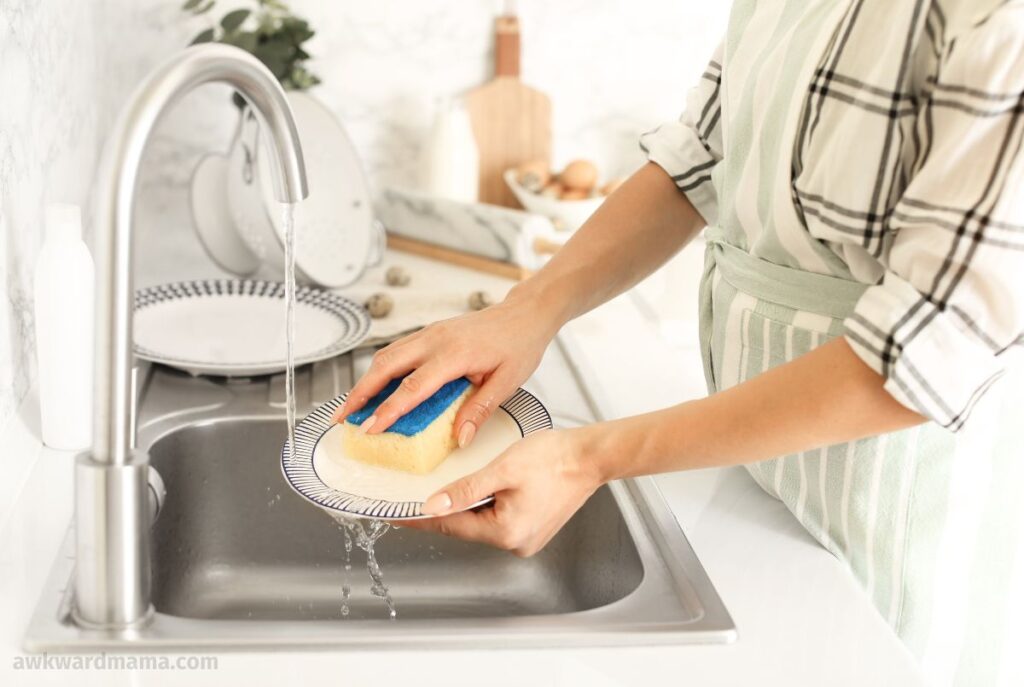
Evenings can get a bit out of hand — sometimes the kids go to bed late, sometimes I’m just absolutely done with the day and don’t want to even acknowledge my kitchen.
But I’ve learned that even the tiniest bit of prep at night pays off big in the morning. And we’re not talking about an Instagram-perfect evening routine here.
My bare minimum is literally just making sure we have a few things clean. That includes breakfast dishes, a coffee cup, and the highchair. That’s it.
When I have the energy, I’ll also do things like:
- Wipe down the counters
- Sweep the floor
- Tidy up the living room
- Pull the trash
This way, I wake up without having things to take care of the second I open my eyes. I can just get through the first part of the morning and relax.
If you want to start a night before routine for moms, pick one thing that will make your morning easier. That’s it. You can add more if you feel like it, but always know your bare minimum stuff.
4. Use a Family Chore Routine That Runs Itself
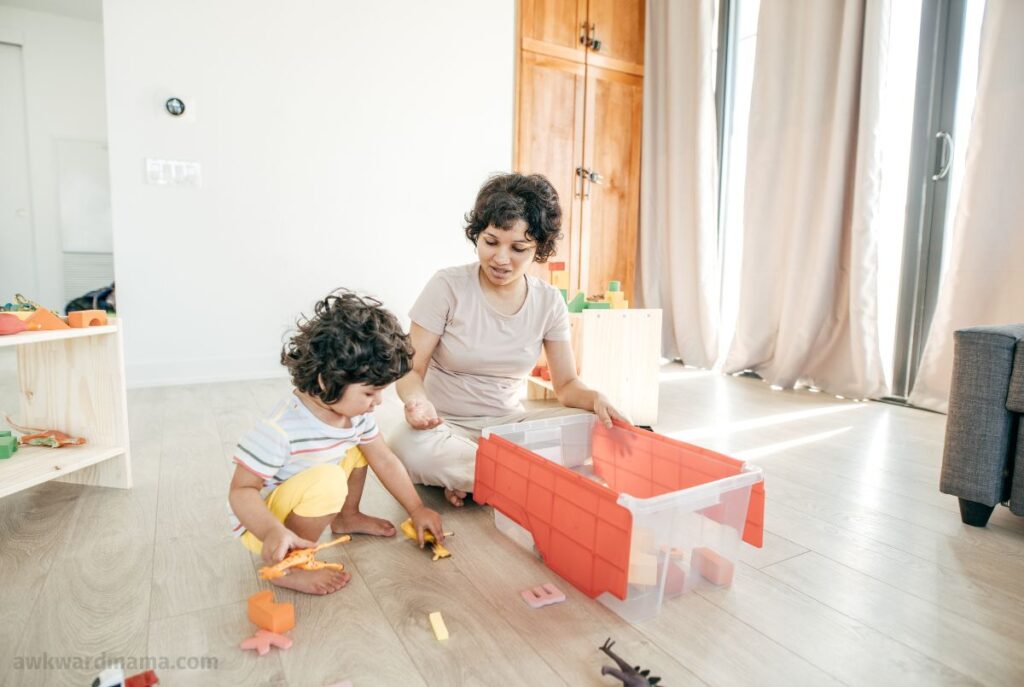
I don’t have the mental energy to micromanage chores for a bunch of kids every day — so we built routines that can keep going without me.
We keep a whiteboard in the hallway near our kitchen with daily chores, big reminders, and the family calendar. Everyone can see what needs to happen, and they know the order: breakfast → morning chores → free time.
The key here though, is that these are family chores. Nobody moves on until all the chores are done. There’s no “your chore” or “my chore” — the whole list belongs to all of us. We work side-by-side, music on, and the energy is “we work together.”
The moment that anyone has an attidude of yours vs mine, they’re corrected immediately. And this means we also have to be up helping, too.
There’s a few things that make our family chore routine work:
- Chores happen at the same time each day (after every meal)
- We do them together (nobody is off playing while others are working)
- The tasks are age-appropriate and specific — “pick up the toys in the living room” works better than “clean up”
- Firm, but gentle boundaries with the kids
A note on that last point there. The boundaries aren’t negotiable.
I’m calm, I’m respectful, but I will stand next to you until it’s done, if needed. I’m not bribing them or yelling, but I am making sure things get done.
Having non-negotiable boundaries with kids is essential in our family.
5. Stay on Top of Chores (Even When You’re Always Behind)
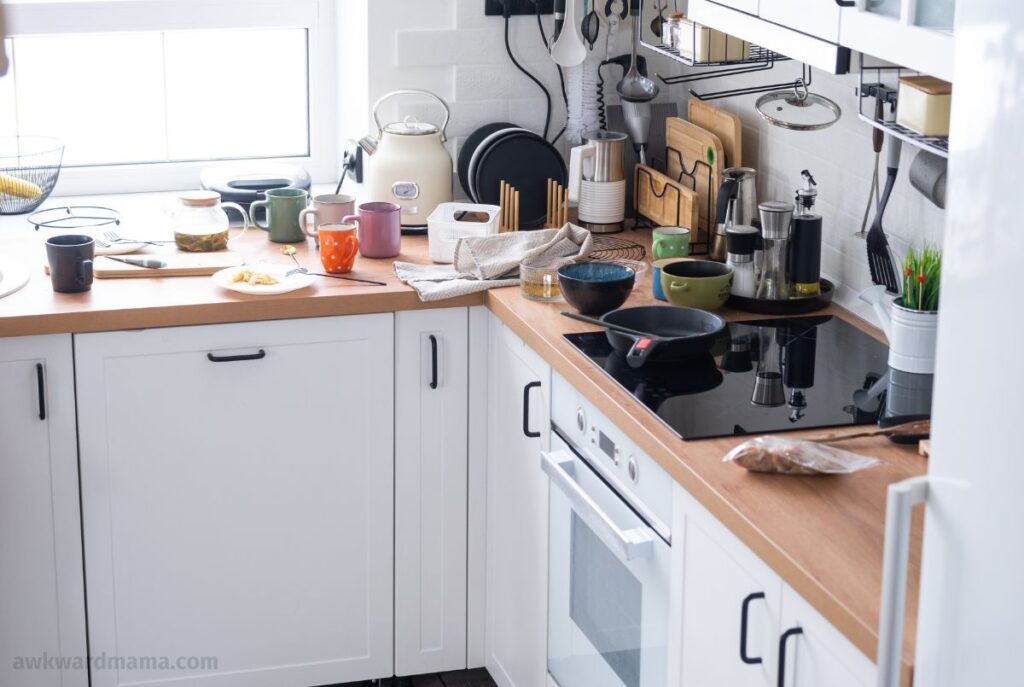
I’m going to be honest — I’m always a little behind on chores. With four kids, the “done” list is never actually done. But routines keep me from feeling buried alive.
There was a time when I felt our house was swallowing us and I’m so glad that’s not our reality anymore. But I’m pretty sure our microwave hasn’t been cleaned in a hot minute.
Instead of trying to do it all, I focus on breaking chores into tiny, quick wins:
- Clear the counters instead of deep cleaning the whole kitchen
- Clean the toilet while I’m already in the bathroom getting dressed
- Grab the trash when we leave to go to the park
When I’m dragging, I start with visual clutter — it’s amazing how much calmer I feel when I can see the floor or the dining table again. And once my body’s moving, it’s easier to keep going.
You don’t need some picture-perfect Pinterest plan (or the mythical “holy grail” home cleaning routine for busy moms).
You just need something that stops the overwhelm spiral — and small wins, stacked one at a time, can do exactly that.
6. Conquer the Laundry Monster

Laundry used to be my arch nemesis. I’d have clean clothes sitting in baskets, piled up on a chair, or in a pile on the floor…. all over the house.
And remembering to switch the laundry? Nah, you mean I washed it for the third time because I kept forgetting before the clothes got old.
Now we have a simple, repeatable system: laundry gets put away in the morning, and a new load gets started around the same time. That load gets switched… at some point (usually). We have the most energy in the morning, and nobody is gonna take care of it at 8 PM, so it works for us to do it in the morning.
Here are a few tips for building a laundry routine that actually works for busy moms:
- Tie it to something you already do every day (like after breakfast)
- Keep laundry baskets where the clothes actually come off
- Don’t aim for perfection — aim for “good enough to keep us in clean underwear”
- Stop folding the laundry. Toss it in a bin and move on. Seriously.
If you can get one load from “dirty” to “put away” each day, you’re winning.
7. Reset Your Day with a Quick Midday Routine

Some days, the first half of the day goes great… and then suddenly everyone is wildly out of control. That’s where my midday reset comes in.
I keep it super simple: we pause, tidy the main spaces for 5–10 minutes, maybe switch laundry, and reset our brains with a snack or a short break. If I really need an energy boost, we get outside, even if it’s just a quick walk to the mailbox.
If I feel like we’re REALLY struggling… we find any excuse to get out of the house for a bit.
If you’ve ever looked up a midday reset for moms… you know they can be complicated. But it doesn’t need to be. The goal is just to stop your day from getting completely derailed.
You can try these daily reset ideas:
- Tidying up the living room together
- Turning on a “pick-up” playlist for everyone to move to
- Head outside for a nice walk together
- Go run some errands just to get out for a bit
The whole vibe is: short, sweet, and resets the tone.
8. Keep Dinners Simple but Consistent

Dinner doesn’t have to be complicated to be consistent. My husband handles most of ours (bless him), but we plan a loose menu for the week and then pick meals as we go.
Some nights it’s BBQ mac and cheese or spaghetti. Other nights it’s microwave chicken burgers or even cereal. The point is, we all eat without it feeling like a massive production.
If you’re building an easy family dinner routine:
- Have 3–5 go-to meals that require almost no thought
- Keep the ingredients for those stocked
- Let go of the idea that dinner has to be “from scratch” every night
- Allow full bellies be enough – it’s okay!
At the end of the day, the best dinner routine is the one that keep bellies full and that you’ll actually keep doing.
9. Make Winding Down a Family Thing

Evenings can be chaotic af if everyone is still bouncing off the walls. Because of that, we made winding down part of our daily rhythm. Every night since the oldest kids were toddlers, we watch a movie together before dinner.
But this isn’t about giving the kids all this screen time, it’s about slowing down to spend time together. We talk, snuggle on the couch, and shift into a calmer headspace.
The only rule is that we don’t get back on screens after dinner until chores are done, which keeps things moving as we move into the evening.
If a family wind-down routine feels impossible, start with one activity:
- A short walk after dinner
- Reading aloud as a family
- Playing a slow-paced board game or puzzle
- Cooking dinner together
It’s less about the activity and more about the signal to our brains that we’re slowing down now. And yes, I have to remind my kids ALOT that it’s time to settle down lol.
10. Use Calming Activities to Help Kids Sleep Better

If bedtime at your house feels like running a marathon in slippers, calming activities can help. We’re currently experimenting with letting the older kids play cozy video games in bed as they wind down — and it’s been surprising so far.
My kids are older now so I wouldn’t suggest that for everyone. When they were toddlers, we read a lot of books. But now they mostly do that on their own or read to the younger kids.
The key here is to transition away from the high energy chaos of the day into calm energy. Some nights that might mean a bath with dim lights and candles (which is my preferred choice). Other nights, it’s doing a fun puzzle, reading a book, or coloring.
These are some of our favorite ideas for calming bedtime activities for kids:
- Audiobooks or soft music in their rooms
- Drawing or journaling in bed
- A warm bath or shower before pajamas
The goal is to help their bodies realize that it’s almost time for sleep.
11. Create Bedtime Routines That Work for Everyone

The fastest way to make bedtime less of a battle is consistency and boundaries that aren’t negotiable.
We’ve been doing this so long now that nobody even argues bedtime anymore. They know they need to get dressed for bed, brush their teeth, get some water, and climb into bed.
If by some chance, a kid does resist, I’ll just offer help. Even if that means I’m literally dressing them like a toddler. They don’t love it, so they usually choose to do it themselves and just follow the routine.
When we first set this up, I expected tantrums, pushback, and a lot of “I’m not tired.” I stayed calm (or at least tried to), held the boundary, and over time, it became just… what we do.
For an easy bedtime schedule for families, try:
- Keeping steps in the same order every night
- Doing as much as you can at the same time each night
- Being willing to calmly follow through, even if it’s inconvenient
- Don’t bend the routine too often (otherwise they’ll beg to do it again night after night)
Bedtime might never be flawless, but with a routine, it stops feeling like an unpredictable fight.
12. Build Habits That Protect You from Burnout

I’ve hit burnout more times than I can count — usually from pushing myself too hard or trying to be a “good mom” (which was really me trying to force myself to be neurotypical).
Now I focus on small habits that keep me out of that hole:
- Refilling my pill container every Saturday night so it’s never empty
- Chugging water everytime I step into the kitchen
- Stepping outside for at least a few minutes every day
- Letting the laundry pile wait if my body says rest
- Building in recovery days after heavy social days
And if I overdo it one week? I let myself take a few days to just rot. I know I’ll head straight to burnout city if I keep trying to push it.
Habits to prevent mom burnout aren’t exactly glamorous like mainstream media wants us to believe. It’s just about making the right choices so we don’t crash into the ground.
Imperfect is fine. Skipping sometimes is fine. What matters is you’ve got a few anchors that keep you from going completely under. We can’t show up for our kids or ourselves that way.
13. Add Quick Self-Care That Actually Fits Your Life

Self-care isn’t a spa day for me — it’s a bath in the dark with candles while my husband keeps the other kids occupied. It’s low stimulation, quiet, and just enough to center me.
With a ton of kids at home with me all day, I get overstimulated by dinner, every night. So it’s a must for me these days.
If I try to force “perfect” self-care routines, I end up skipping them entirely. Instead, I fit them around things I’m already doing.
- Listen to energizing music while we do chores
- Sit and sip my coffee while I play a game on my phone
- Watch my favorite show while feeding the baby
- Read a book while the kids watch cartoons before bed
Self-care for moms with no time has to be easy enough that you’ll actually do it. It doesn’t need to fit some perfect image of what self care is “supposed to” look like.
It just needs to work for you.
14. Teach Kids Routines (Without the Power Struggle)

I’ve learned that kids don’t magically “just know” routines — they learn them the same way we do: repetition, modeling, and boundaries.
And they definitely don’t know what they are if you don’t communicate them. (aka keep them tucked away in your phone)
I’ve mentioned this a few times now in this post, but when my kids drag their feet on chores, I just stand with them until it’s done.
I’m not yelling, bribing them, or threatening them. I’m just very firmly enforcing the bouondary. I respect them as people, but I also hold the line. Over time, they stop fighting because they know it isn’t optional.
Because even if we think that telling them they can either do chores or lose something… that’s still a choice. They can choose to lose something to get out of chores.
But if they know it will get done one way or another… they’ll just do it with enough consistency of sticking to your boundaries.
If you want rountines to stick for kids with ADHD or those who forget… you need to:
- Keep routines short and visual (charts, whiteboards, pictures)
- Model doing it yourself alongside them
- Offer help instead of ultimatums (“Do you want to do it, or should I help?”)
Oh and help is not doing it for them. It’s doing it with them so they learn the skill.
It’s all about showing them “this is just what we do” until it clicks.
15. Have a “Bare Minimum” Backup Plan for Hard Days

Even with great routines, there are days when I’m just done. Sick days, low-energy days, mental health crash days, or pregnancy — whatever the reason, I need a plan that keeps us afloat without expecting too much.
My bare minimum routine is simple:
- Make sure we have clean dishes for breakfast
- Have clean clothes for tomorrow
- Keep the kids fed (even if it’s cereal for dinner)
- And hopefully not break down into a pile of tears by the end of the night
Everything else can wait. When I give myself permission to scale back, it keeps me from falling into full-blown survival mode — because I’m still doing the essentials without burning myself out further.
And there’s something different about binging your favorite show all day when you’re intentionally doing it. You’re giving yourself permission to just take a day.
The house won’t burn down overnight, I promise.
16. Do a Weekly Reset to Keep Life on Track
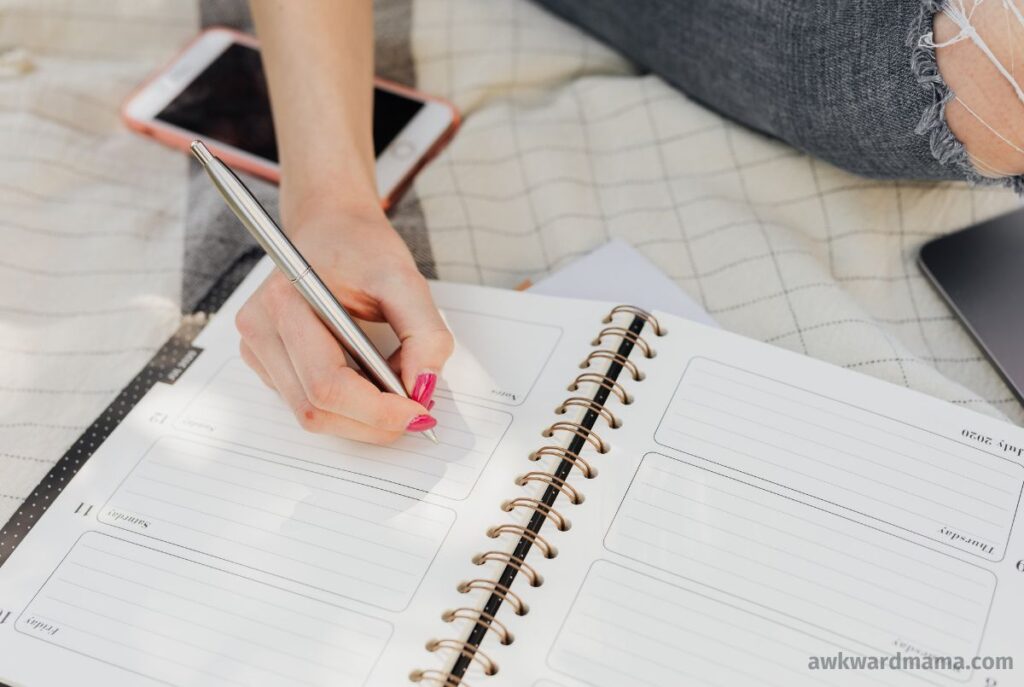
I don’t “set aside a block of time” for a weekly reset. I just do the things that feel important to set myself up for the week ahead. Most weekends, very few things have to happen at a specific time, so I follow my energy and knock things out as I feel like it.
I check our shared familyGoogle Calendar for appointments and update our family’s dry-erase boards. It’s super important that the kids know what’s happening ahead of time.
The big board in our main space lists events, routines, and the weekly schedule. I also update our chores board if needed so it’s crystal clear what needs to be done. Like if kids rooms are getting out of control… I’ll write it on the board so it actually gets cleaned.
Some things I make sure happen every week while others I might skip:
- Refill my pill container on Saturday night (so I don’t skip doses)
- Double-check appointments for the week
- Make sure the kids have what they need for lessons, outings, or projects
- Clear the main spaces so Monday starts calmer
A weekly reset doesn’t have to be this stiff thing our brain resists. It can be relaxing and supportive. It’s just about resetting the essentials so you start the week feeling good.
Final Thoughts

Routines are meant to work for you, not the other way around.
You don’t need to overhaul your life or run on someone else’s system. You don’t have to do all 16 of these at once. Start with one change, let it become second nature, then stack on another.
You’ll mess up some days. You’ll skip steps. And that’s fine — imperfect consistency still makes life easier.
The real win? You wake up knowing what happens next, the kids know what to expect, and the day feels less like chaos and more like a flow you can actually live in.
You’ve got this, mama — one small, doable routine at a time. 💖





